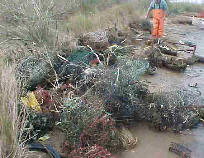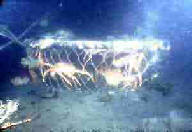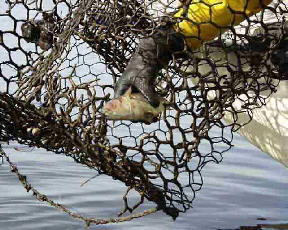|
The Evaluation of Ghost Fishing Preventors for Shellfish Traps: MAFF Study MF0724
This research project was funded by the Chief Scientists' Group the Department of the Environment, Food and Rural Affairs, ). It has been conducted by Sea Fish Industry Authority, and ran from July 1999 to December 2000.
Introduction and Objectives
This study investigated the phenomenon of ghost fishing by shellfish traps. Ghost fishing can occur when fishing gear is lost from the control of its owner, and continues to produce fishing mortality. The work came about through an initiative of the largest fishermen's association representing this sector in the UK. There were four objectives:
1. To investigate the extent and nature of problems associated with ghost fishing by shellfish traps that have become permanently lost.
2. To identify the range of materials and devices available to solve the problems identified.
3. To identify the range of conditions under which the devices would have to operate.
4. To perform field trials, with appropriate controls, in order to evaluate the performance of the devices.
Materials and Methods
The project team undertook a survey of fishermen's experiences of gear loss in the Southwest and Northeast of England and on the West Coast of Scotland. The survey quantified effort levels, identified the main reasons for losing shellfish traps and looked at fishermen's perceptions of the phenomenon.
The team then identified devices used in other fisheries in order to disable lost traps. A range of these devices was obtained and evaluated. This process involved trials under controlled conditions in a Scottish sea loch and the use of the devices by commercial fishermen. These trials were to evaluate both the reliability of the devices and their practicality for commercial use.
Results
The survey showed that most fishermen do not believe that lost traps pose a threat to stocks. Many of those interviewed had recovered traps lost for varying periods of time, and they seldom contained any catch. In most cases they were damaged and had no residual fishing capability. There are some objective data which supports evidence that there are other, more significant sources of mortality on shellfish species than ghost fishing.
The disabling devices ranged from simple lengths of sisal twine to purpose-made corroding links that can be supplied calibrated for given immersion times. All of these worked, but not always in a predictable way. Cost-effectiveness is also a major consideration, given the number of traps that may now be worked by shellfish vessels.
Conclusions
1. Most trap fishermen surveyed did not consider that there was a conservation problem associated with lost traps. All the anecdotal evidence (backed by some data) supports the view that most lost traps become disabled over a period of some months.
2. If areas or fisheries are identified as being particularly susceptible to loss then a range of technical measures are available which will mitigate any ghost fishing that might result. Samples of these were obtained and examined.
3. Further field work identified the operating conditions that the devices would need to withstand at sea in the main trap fishing regions.
4. In field trials, all the devices were found to perform satisfactorily, but other factors also had to be taken into account. These included the ease of renewing them at sea, their cost and their life to failure. The most widely applicable device was a drop-out panel held in place by mild steel wire rings.
From Arkley and Swarbrick 2001, The evaluation of ghost fishing preventors for shellfish traps, final project report, study reference MF0724: Impact of Fishing. 20pp. Currently awaiting public release.
|




